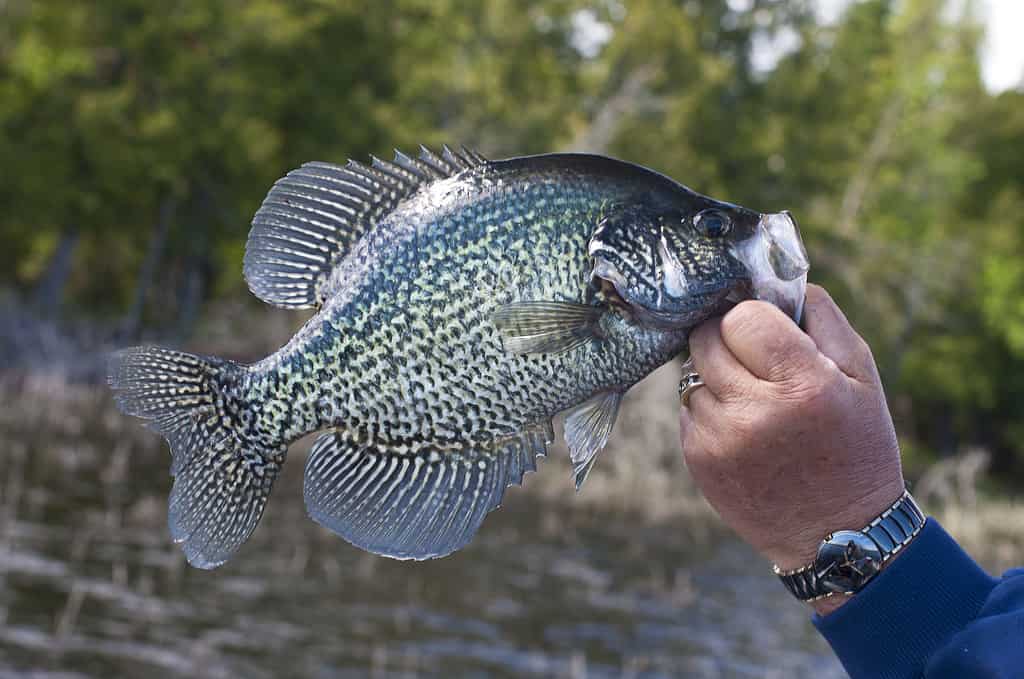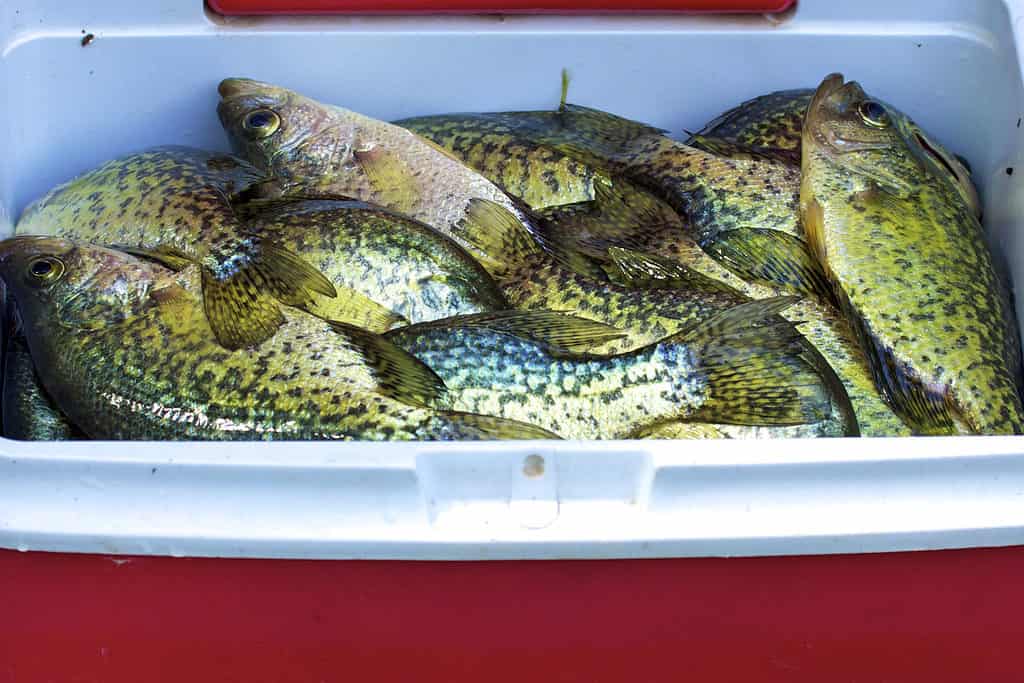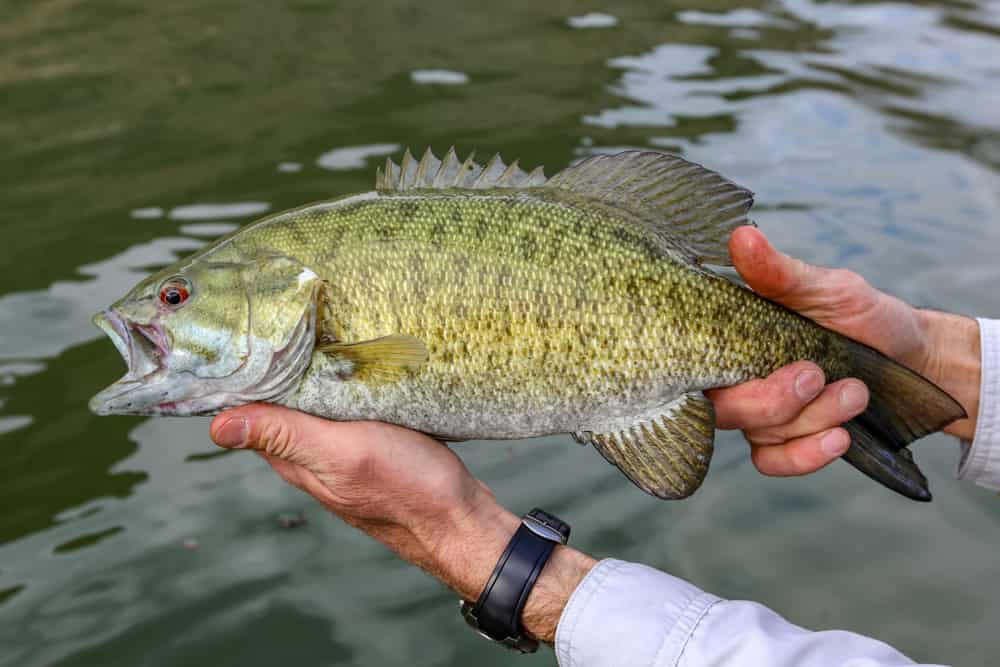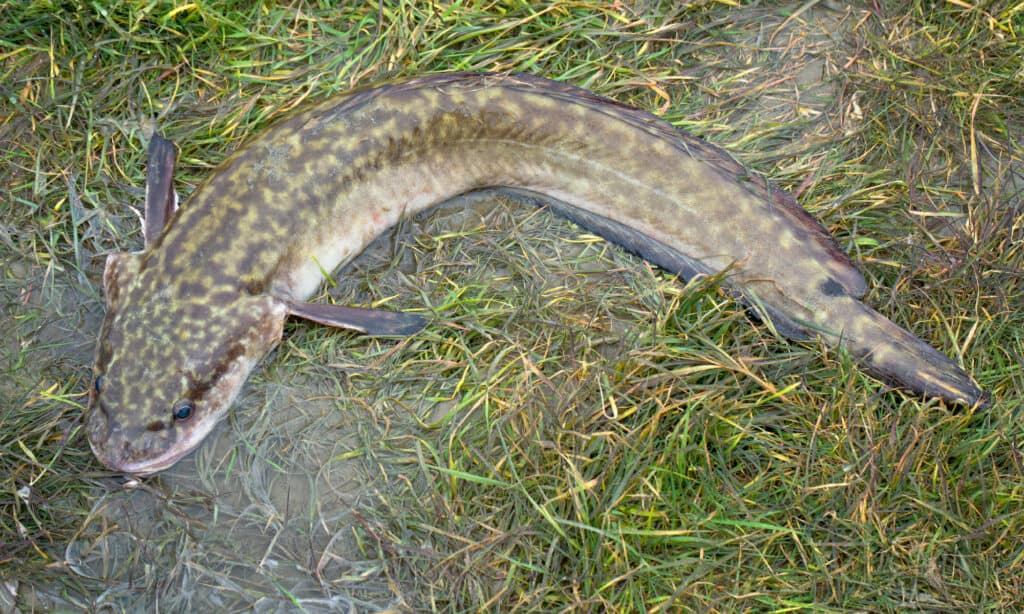Black crappie are shiny freshwater fish that are fun to try and catch. In Washington State, they are very common. You can find them in Frank’s Pond, Horseshoe Lake, Silver Lake, Lake Goodwin, and Franklin Roosevelt Lake. Can you guess the size of the largest black crappie ever caught in Washington? Or where it was found? Keep reading to find out!
What is the Largest Black Crappie Ever Caught in Washington?
The largest black crappie ever caught in Washington State weighed 4.50 pounds. John W. Smart caught this impressive fish on May 1, 1956, in Lake Washington. He’s held this record for over 60 years. Although impressive, this record pales in comparison to the largest black crappie ever caught and recorded. The world record black crappie weighed 5 pounds and 7 ounces.

The largest black crappie ever caught in Washington was 4.50 pounds.
©SteveOehlenschlager/iStock / Getty Images Plus via Getty Images
About Black Crappie
Black crappies are vibrant freshwater fish. Although they are nowhere near as large as largemouth bass, black crappie are popular fish for anglers. They are best caught in clear water using minnow rigs. These lovely fish are members of the Centrarchidae family.
Description and Size
Black crappies are about 4 to 8 inches long, although they can reach more impressive lengths. They also weigh about 3.3 pounds, sometimes even less. Black crappies are beautiful fish. They are very colorful and generally have seven or eight spines on their dorsal fins. They are also long and flatfish. Most black crappies are silvery-grey and green, with unique black marks on their bodies. Black crappies also have large mouths, wide eyes, and thin lips.

Black crappies aren’t entirely black. They are mainly silver-grey and green.
©Jarrod Erbe/Shutterstock.com
Habitat and Distribution
Interestingly, experts aren’t sure of the exact native range of black crappies. They’ve been so widely introduced and spread that it’s hard to identify. However, some experts believe the origin of black crappies in North America. In North America, they are extremely common in the eastern United States and Canada. Black crappies though are present in all 48 continental states.
These vibrant shimmering fish live in lakes and pools in larger rivers. They typically live in clear waters with minimal to no current. Black crappies also prefer a lot of vegetation to hide from predators at the bottom of lakes and rivers.
Diet
So, what do black crappie fish eat? Black crappies mainly eat plankton and small fish. Their diet though depends on their size and age. Adult black crappies though, don’t just eat fish. They also consume large amounts of insects and crustaceans.
Predators
Black crappies have a lot of predators. They are small fish that depend on their hiding skills and vegetation to stay clear of predators. Black crappies are hunted by humans, large piscivorous fish, and birds.
Other Fish in Washington State
Now that we’ve learned a little more about black crappies, we can dive into other common fish in Washington State. Within Washington are various freshwater fish to catch. Listed below are a few with some fun facts and the Washington state record.
Tiger Muskie
The tiger muskie, also known as the tiger muskellunge, is a hybrid of the true muskellunge and the northern pike. They range in size and coloration, taking characteristics from both parents. The largest tiger muskie caught in Washington State weighed 37.88 pounds. David Hickman caught this large fish in Curlew Lake in 2014.

Tiger muskies are hybrid fish.
©M Huston/Shutterstock.com
Yellow Perch
Another fish you can find in Washington State is the yellow perch. The yellow perch is a vibrant yellow fish with a large range. This lovely fish is about 4 to 10 inches long and weighs up to 4 pounds and 3 ounces. But what about Washington State’s record? The largest yellow perch ever recorded in Washington weighed 2.75 pounds. In 1969, Larry Benthien caught this yellow perch in Snelson’s Slough.

Yellow perch are about 4 to 10 inches long.
©RLS Photo/Shutterstock.com
Smallmouth Bass
The next fish on our list is the smallmouth bass. They are found in freshwater lakes and rivers with an average temperature of around 67 to 71 °F. Smallmouth bass live in clear and cool waters. They are powerful swimmers and reach up to 11.94 pounds. The largest smallmouth bass ever caught in Washington was 8.75 pounds.

The world record smallmouth bass is 11.94 pounds.
©CSNafzger/Shutterstock.com
Burbot
Burbot is a freshwater cod-like fish with many names. It’s sometimes called the freshwater ling, freshwater cusk, lingcod, and cusk. Burbot fish are sometimes described as catfish and eel-like fish. It’s listed as Least Concern on the IUCN Red List. In 2004, Mike Campbell caught a 17.37-pound burbot in Bead Lake.

The largest burbot ever caught in Washington State weighed 17.37 pounds.
©iStock.com/Krugloff
Green Sunfish
Last but not least is the green sunfish. The green sunfish is native to large parts of North America. They’ve also been introduced to many lakes in the United States, including Arizona, New Jersey, and Florida. These pretty fish are small, with a maximum weight of 2.12 pounds. The largest green sunfish caught in Washington State weighed 0.79 pounds.

Green sunfish are small panfish found throughout the United States.
©Sean McVey/Shutterstock.com
The photo featured at the top of this post is © Smithsonian Environmental Research Center / CC BY 2.0, Flickr – License / Original
Thank you for reading! Have some feedback for us? Contact the AZ Animals editorial team.







